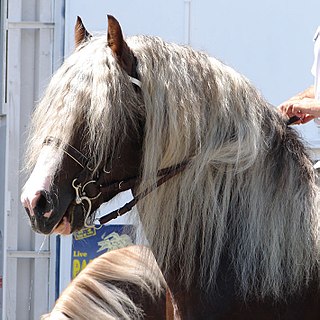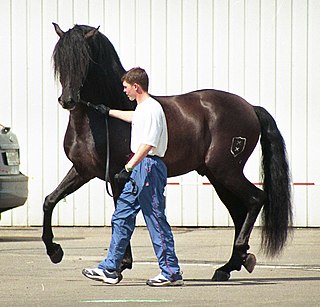A horse breed is a selectively bred population of domesticated horses, often with pedigrees recorded in a breed registry. However, the term is sometimes used in a broader sense to define landrace animals of a common phenotype located within a limited geographic region, or even feral “breeds” that are naturally selected. Depending on definition, hundreds of "breeds" exist today, developed for many different uses. Horse breeds are loosely divided into three categories based on general temperament: spirited "hot bloods" with speed and endurance; "cold bloods," such as draft horses and some ponies, suitable for slow, heavy work; and "warmbloods," developed from crosses between hot bloods and cold bloods, often focusing on creating breeds for specific riding purposes, particularly in Europe.

A draft horse (US), draught horse (UK) or dray horse, less often called a carthorse, work horse or heavy horse, is a large horse bred to be a working animal doing hard tasks such as plowing and other farm labor. There are a number of breeds, with varying characteristics, but all share common traits of strength, patience, and a docile temperament which made them indispensable to generations of pre-industrial farmers.

The Friesian is a horse breed originating in Friesland, in the Netherlands. Although the conformation of the breed resembles that of a light draught horse, Friesians are graceful and nimble for their size. It is believed that during the Middle Ages, ancestors of Friesian horses were in great demand as war horses throughout continental Europe. Through the Early Middle Ages and High Middle Ages, their size enabled them to carry a knight in armour. In the Late Middle Ages, heavier, draught type animals were needed. Though the breed nearly became extinct on more than one occasion, the modern day Friesian horse is growing in numbers and popularity, used both in harness and under saddle. Most recently, the breed is being introduced to the field of dressage.

The Lipizzan or Lipizzaner, is a horse breed named for the Lipizza Stud of the Habsburg monarchy. The breed is closely associated with the Spanish Riding School of Vienna, Austria, where the horses demonstrate the haute école or "high school" movements of classical dressage, including the highly controlled, stylized jumps and other movements known as the "airs above the ground." The horses at the Spanish Riding School are trained using traditional methods that date back hundreds of years, based on the principles of classical dressage.

Classical dressage evolved from cavalry movements and training for the battlefield, and has since developed into the competitive dressage seen today. Classical riding is the art of riding in harmony with, rather than against, the horse.

The Iberian horse is a designation given to a number of horse breeds native to the Iberian peninsula. At present, some breeds are officially recognized by the FAO, while other horses believed to be native to the peninsula are not. Likewise, some modern breeds are understood from mitochondrial DNA to be descended from historic landraces, while others have origins outside the Iberian peninsula. The remaining FAO-recognized breeds are of well-known foreign blood, or are recently developed breeds.

The Lusitano, also known as the Pure Blood Lusitano or PSL, is a Portuguese horse breed. Horses were known to be present on the Iberian Peninsula as far back as 20,000 BC, and by 800 BC the region was renowned for its war horses. The fame of the horses from Lusitania goes back to the Roman Age, which attributed its speed to the influence of the West wind, who was considered capable of fertilizing the mares. When the Muslims invaded Iberia in 711 AD, they brought Arabian horses with them that were crossed with the native horses, developing a horse that became useful for war, dressage and bull fighting. The Portuguese horse was named the Lusitano, after the word Lusitania, the ancient Roman name for the region that modern Portugal occupies. There are four main breed lineages within the breed today, and characteristics differ slightly between each line.

The Sorraia is a rare breed of horse indigenous to the portion of the Iberian peninsula, in the Sorraia River basin, in Portugal. The Sorraia is known for its primitive features, including a convex profile and dun coloring with primitive markings. Concerning its origins, a theory has been advanced by some authors that the Sorraia is a descendant of primitive horses belonging to the naturally occurring wild fauna of Southern Iberia. Studies are currently ongoing to discover the relationship between the Sorraia and various wild horse types, as well as its relationship with other breeds from the Iberian Peninsula and Northern Africa.

The destrier is the best-known war horse of the Middle Ages. It carried knights in battles, tournaments, and jousts. It was described by contemporary sources as the Great Horse, due to its significance.

On horses, the mane is the hair that grows from the top of the neck of a horse or other equine, reaching from the poll to the withers, and includes the forelock or foretop. It is thicker and coarser than the rest of the horse's coat, and naturally grows to roughly cover the neck. Heredity plays a role, giving some horses a longer, thicker mane, and others a shorter, thinner one.

The Spanish walk is a trained movement performed by a horse. While at a walk, as the horse raises each foreleg off the ground, it lifts the leg in an exaggerated upward and forward manner. While the Spanish walk is loosely affiliated with the field of dressage, it is more of a trick or circus movement and not included in any modern dressage tests. It is often taught to horses of the Andalusian and Lusitano breeds and is considered a part of the horse culture in Spain. The action is said to benefit the horse by helping it learn to open up its shoulder movement.

The Friesian Sporthorse is a Friesian crossbred of sport horse type. The ideal Friesian Sporthorse is specifically bred to excel in FEI-recognized sport horse disciplines. Thus, "sporthorse" refers to the phenotype, breeding, and intended use of these horses.

The heavy warmbloods are a group of horse breeds primarily from continental Europe. The title includes the Ostfriesen and Alt-Oldenburger ("Old-Oldenburger"), Groningen, and similar horses from Silesia, Saxony-Thuringia, and Bavaria. Breeds like the Hungarian Nonius, Kladruber, and Cleveland Bay are also often classed as "heavy warmbloods." They are the ancestors of the modern warmbloods, and are typically bred by preservation groups to fit the pre-World War I model of the all-purpose utility horse. Unlike the registries of the sport horses that followed them, many heavy warmblood registries maintain closed or partly closed studbooks. However, external evaluation and performance testing of the breeding stock is still a key element in these registries. Many of the heavy warmbloods are selected primarily for family-friendly temperaments.

The Frederiksborger is Denmark's oldest horse breed. They were tremendously popular throughout the Renaissance and Baroque periods and were considered luxury items. Today, the breed is rare, but has a loyal following. Stallions and mares undergo studbook inspections before being allowed to breed. They are most often chestnut with white markings.

The Andalusian, also known as the Pure Spanish Horse or PRE, is a horse breed from the Iberian Peninsula, where its ancestors have lived for thousands of years. The Andalusian has been recognized as a distinct breed since the 15th century, and its conformation has changed very little over the centuries. Throughout its history, it has been known for its prowess as a war horse, and was prized by the nobility. The breed was used as a tool of diplomacy by the Spanish government, and kings across Europe rode and owned Spanish horses. During the 19th century, warfare, disease and crossbreeding reduced herd numbers dramatically, and despite some recovery in the late 19th century, the trend continued into the early 20th century. Exports of Andalusians from Spain were restricted until the 1960s, but the breed has since spread throughout the world, despite their low population. In 2010, there were more than 185,000 registered Andalusians worldwide.
Georgian Grande Horse is a new horse breed being developed from crossbreeding the American Saddlebred with the Friesian horse and assorted draft horse breeds. The aim of the breeding is to create a Saddlebred-like horse that adds the best qualities of heavier breeds. One goal of the breed registry is to recreate a historic type of Saddlebred which was common prior to the 20th century, but that has been less emphasized in modern times.

The Warlander is a horse of Baroque type, produced by crossing Friesian horses with horses of a purebred registered Iberian horse breed such as the Andalusian, Lusitano, or Menorquina. The ideal Warlander combines the Iberian horse's intelligence, facility for collection, flexibility, and powerful hindquarters, with the Friesian's tractability, dramatic leg action, "bone," and strong forequarters.
Marji Armstrong is one of the pioneers of the classical philosophy of horsemanship in Australia. She has taught these classical principles to students around the world for the past two decades, both in person and via the internet, and now shares her thoughts and experience on Marji's Blog.

The Escola Portuguesa de Arte Equestre is a Portuguese institution dedicated to the preservation of the equestrian arts, in the Portuguese tradition. It is one of the "Big Four", the most prestigious classical riding academies in the world.

















